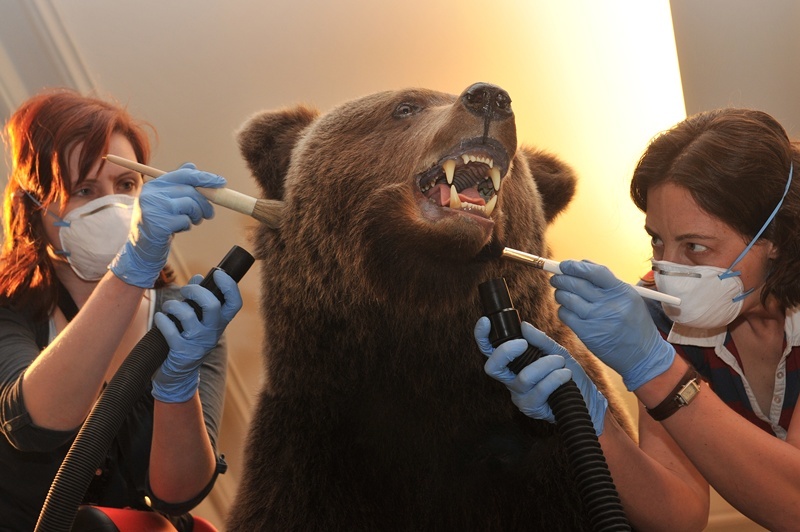The thought of holding a vacuum cleaner up to a bear’s behind or brushing a wolf’s teeth may seem ludicrous, but to staff at The McManus it’s all in a day’s work.
Curators and conservators at Dundee’s museum have embarked on an unusual spring clean, attacking the stuffed animals of the Landscapes and Islands galleries first.
”It’s not every day you get to Hoover a bear,” geology and zoology curator David Lampard said as he dusted down the glass cases of the gallery. ”This is my gallery, so I normally look after the lighting and labelling, but this is a pretty major job. It’s all hands to the pump.”
Various brushes, dusters and attachments were strewn across the exhibition floor as staff crawled under lynxes and otters, delicately removing the film of dust that has built up since the galleries reopened in March 2010.
The spring clean was being orchestrated by conservator Rebecca Jackson-Hunt, who joined The McManus from the Riverside Project in Glasgow just before Christmas.
”We’re hoping to get all of it done in a week,” Rebecca said, perched on top of a glass cabinet, surrounded by bears and boars. ”We’ve the Landscapes and Islands galleries to do, Making Modern Dundee, Dundee and the World and the Victorian Gallery.”
Rebecca and zoology and botany curator Julie Campbell began to meticulously clean a bear with its bared teeth using a special vacuum and tiny soft brushes.
”We’re using the conservation vacuum so it’s just suction and not pulling the hair off,” Rebecca explained. ”If you put water on dust you’re just creating mush. We start with a dry clean because if dust is left on an object it will actually bond. We’re hoping to do this once a year.”
As well as dusting the exhibits, the team were busy checking pest traps for moths and bugs while they carried out a hunt for woodworm death to any gallery. Luckily there was not so much as a telltale hole in sight.
The McManus will remain open throughout the clean to provide the public with an insight into the upkeep of the gallery and the team are putting all their technical know-how into play.
Voted Dundee’s best-loved building in 2000, The McManus is home to eight galleries and journeys through 400 million years of local history.
The landscape gallery where the clean began is meant to resemble how Dundee would have looked at the end of the last Ice Age, before any human activity, but as David explained it has become a bit of a moveable feast.
He said: ”The idea with the top of the exhibition is to have animals which used to live here but have become extinct in the area. We put a beaver in the case just as they were starting to reintroduce them and people are talking about reintroducing wolves and lynxes.
”Otters have come back on their own and wild boars keep making escapes from abattoirs.”
He added that climate change could also mean some of the animals shown in the displays depicting wildlife could be forced from the area in coming years.
”With birds like ptarmigans and snow buntings, if it got really warm it would be a question of whether they would still survive here or have to be moved somewhere further north like Scandinavia,” David said.
